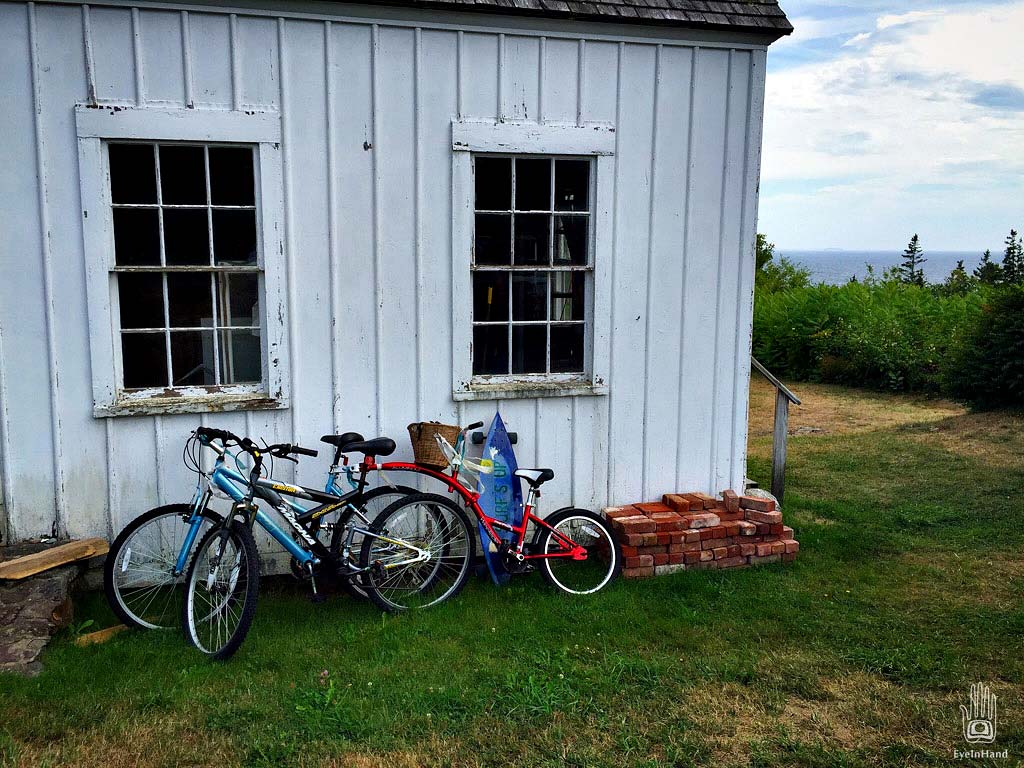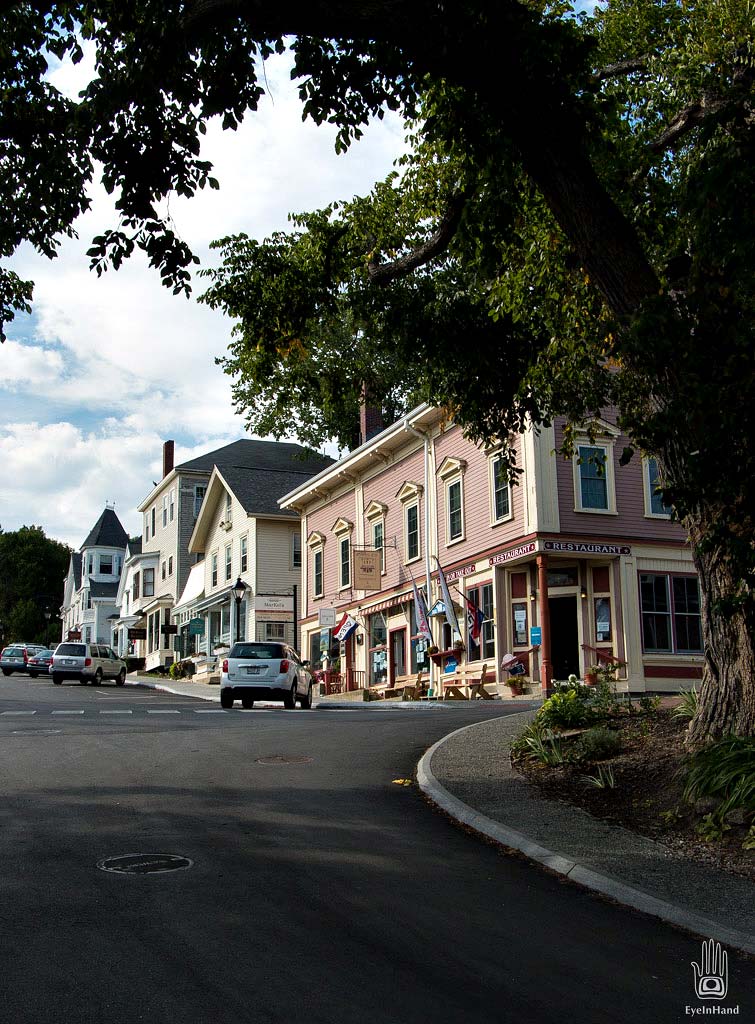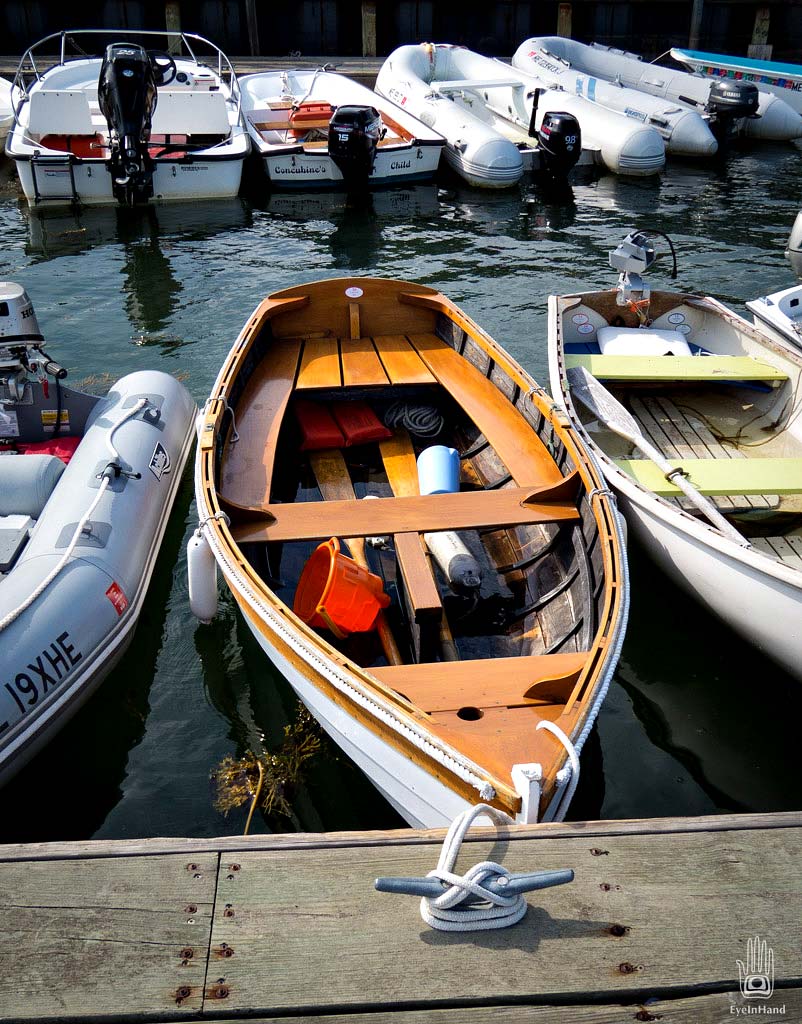School on the Commons ~ Castine, Maine
From the airport in Bangor to Stonington, at the southern tip of Deer Isle, should take about an hour and a half. We spend four hours doing the same, winding along the Penobscot River, stopping in towns along the way, generally assuming the least straight path presented.
First stop is Bucksport, where there’s a farmers market still open. Terri, very excited, insists we stop, and goes in for provisions. She gets caught in various eddies, long chats with local farmers, and does not resurface. I wander the main street, still a little too travel-frazzled for conversation. We had reserved a little Toyota Corolla rental car in advance, but by the time we arrived those were all gone. So, for the same rate, they gave us the only thing left – a fancy new Cadillac. This would normally be a good thing.
 Main Street ~ Bucksport, Maine
Main Street ~ Bucksport, Maine
However, our own cars are over a decade old – analog knobs and cassette players in the dash, not even luxury models when new. I am ill-prepared for the advanced electronics: automatic everything, beepers going off constantly, radar and video screens, and touch activated non-buttons trying to anticipate one’s every whim before one has whimmed it. Just unlocking the door for Terri requires several minutes of trial and error, which of course activates the car alarm alarmingly. So at the first opportunity I am glad to get out of it and walk a bit.
 Not a Corolla ~ Dice Head Lighthouse, Castine
Not a Corolla ~ Dice Head Lighthouse, Castine
 View of the sea, with bikes ~ Dice Head Light, Castine
View of the sea, with bikes ~ Dice Head Light, Castine
Bucksport is a small town. It straddles the two lane highway on one side, which serves as Main Street. On the other side, close by and below, is the Penobscot River, which here is a deep estuary. Like two Main Streets. From the sidewalk you can see the town’s small marina just back of and below the row of shops, and beyond that downriver through the winding fjord to a high single span bridge that leads south toward Camden.
The river is navigable for ocean-going ships all the way to Bangor. From Bangor it snakes inland across the entire state of Maine. all the way to the Canadian border, draining over 8000 square miles of mostly uninhabited forest. Maine is the most heavily forested state in the US, over 90% coverage, so there’s not a lot else along the banks besides trees and wildlife. This made the river a convenient conduit for floating timber downstream to ports and shipbuilding centers along the coast for hundreds of years.
Across the river on the steep southern bank is the large granite edifice of Fort Knox. Apparently, the Massachusetts Colony did a lousy job of protecting the coast of Maine during certain unpleasantries with the British, who basically ransacked the region during the Revolutionary War and War of 1812. Defenses included a US naval defeat so notable it was not surpassed until Pearl Harbor. After that, folks here took matters into their own hands, declared themselves a state, and got the Federal Government to fund a fort.
Construction costs exceeded a million dollars when it was completed in 1840. Bonus items included furnaces to heat cannonballs so hot they would set wood ships on fire, were they to ever fire upon one. However, the sudden advent of ironclads quickly rendered this nifty feature more a novelty than fearsome weapon.
Forts sort of went out of fashion about the time the fort was finished, and people lost interest. By the end of the Spanish-American War in 1898, the entire garrison consisted of one man, who remained on the site officially as “The Keeper of the Fort” until 1923. The fort never fired a shot in anger, but it sure looked impressive.
Because it was built so well of solid granite, and never saw battle, the whole fort is essentially intact and nearly good as new. It’s now maintained as a landmark by a non-profit organization. I wish we had time for a visit. Even from Bucksport it looks impressive.
 Maine Maritime Academy Training Ship ~ Castine
Maine Maritime Academy Training Ship ~ Castine
We make our way further downriver to the pretty town of Castine, which, though small, is quite a bit larger than Bucksport. Neighborhoods of fine old historic homes cascade down a hillside to a big, well-protected harbor. We head directly for the waterfront and are rewarded with sweeping views north and south over flocks of boats of all kinds – new and old, sail and power, pleasure and working. There’s a big ship at the dock, mounted by a long gangway. It’s the training ship for the Maine Maritime Academy based here. Apparently, this maritime training facility is a public college, one of only six maritime academies in the country.
 Elm trees still frame the town ~ Castine, Maine
Elm trees still frame the town ~ Castine, Maine
While taking a photo of a beautiful elm tree framing a view of the town up the hill, a woman exits a nearby door and waves me over. She’s the docent of the little museum and visitor’s center and, though it’s closing time, immediately engages me in friendly conversation. Turns out a lot of Virginians are in town, including the recent past president of UVa in Charlottesville, whose last name happens to be . . . um . . . Casteen. Nice man with a nice family, very gracious. We had dinner in their house (with about 100 other people) when we were part of a literary festival sponsored by the university. Terri frequently chatted with them around town.
Our helpful docent pointed out their house up the hill, as well as drives we should take before leaving: through neighborhoods of grand old houses, the town Commons, and to the lighthouse.
 Porch Painting, old school on the Commons ~ Castine
Porch Painting, old school on the Commons ~ Castine





“She gets caught in various eddies, long chats with local farmers, and does not resurface.” Sounds like the perfect start to a great vacation.
Indeed, it was . . .